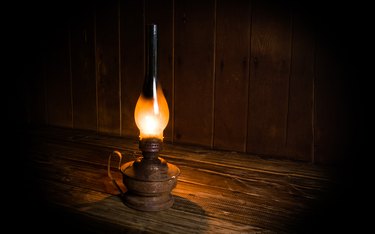Light is important. It's always been a focal point in homes for families throughout history. Light has gone from a simple fire to torches, and then to kerosene oil lamps. So many antique lamps were designed for aesthetics and durability, which is why people collect them to this day.

Image Credit: EvBuh/iStock/GettyImages
But there are a lot of different types of antique lamps as well as modern replicas that are antique-styled. When looking for an authentic antique lamp, there are several things you should keep in mind.
Advertisem*nt
Video of the Day
Oil Lamps Leading Up to the 1700s
Most early antique oil lamps were more functional than decorative and sometimes wasted oil. But in the early 1700s, the Betty style oil lamp was created, which was an improvement on older models featuring uncovered dishes that wasted oil and produced too much spoke. It's made of metals, such as tin, copper or bronze, and has a pick on a chain to grasp a dropped oil wick. The Betty style oil lamp was also designed to be hung up to light a room, and was very popular among colonialists.
Advertisem*nt
Another popular oil lamp style in the 1700s was the center draft lamp, which used a cylinder-shaped wick and a chimney to help air flow to the wick. This is the first lamp to have a mechanism that easily allows for the wick to be lowered in and out of the oil. The center draft lamp is a classic oil lamp style that features a cylinder-like glass that is a little wider at the base, and has a simple container at the bottom to catch the oil.
Advertisem*nt
Oil Lamps in the 1800s
Oil lamps had evolved in the 1800s. Kerosene was used instead of animal oils, and the styles become a lot more ornamental.
Gas lights were also introduced in this century. By the mid-1800s, oil lamps began to be made from thick, clear glass. Some of the glass would be colored to provide an artistic element to homes. The most common hues were emerald green, amber, blue and cranberry red.
Advertisem*nt
However, from the 1860s to the 1880s, oil lamps began to have figural stems. So instead of the bases and stems that were made from the same glass as the rest of the lamp, there were small cast iron statues of classical busts, historical figures and even animals to hold on to when picking up the lamps.
Parlor lamps with brightly painted matching glass shades and bases were also popular in the late 1800s. These kerosene lamps had brass fixtures that held the shade and base together, and were easier to fill than earlier models.
Advertisem*nt
Advertisem*nt
Oil Lamps in the 1900s
By the 1900s, the use of electricity and incandescent light bulbs began to spread, but some oil lamps were still being used. One of the most popular oil lamps in the 1900s was the Aladdin mantle lamp. This style of lamp can wall-mounted or used as an oil pot lamp that's meant to be portable. The Aladdin mantle lamp was made from brass and steel, and came in a variety of styles that customers could choose from.
Advertisem*nt
They didn't have an uncovered wick like some earlier lamps. Instead, the Aladdin mantle lamp had metal burners for the oil flame. The burner had a lot of little holes on it to give the flame oxygen. The lamp also had a "medallion" with the Aladdin company name on it.
Antique Style vs. Real Antique
Antique-styled oil lamps are sold on the market all the time. They have the charm of an antique lamp and sometimes work similarly, but they are definitely not the same. Antique-styled oil lamps made today are decorative and not as sturdy as real antique oil lamps.
Advertisem*nt
Real antique lamps do not have a base that is glued to the font, which is another glass piece. They were fused together when the glass was still hot. Newer replicas, however, are glued together. If exposed to a black light, the glue residue would show on a newer lamp.
Unique antique lamps, especially those made during the Victorian era, had glass that was hand blown. Because of this, there is always a distinctive bump, indentation or spot where the glass was cut from the stem after it was shaped for the lamp. Newer lamps do not have those bumps because many of them are factory-made.
Advertisem*nt
There are also hardware differences between real antiques and antique-styled oil lamps. Antique lamps have a metal fitting collar that screws into the burner, a metal font-to-base connection and metal fitting holes where the oil is poured into. A real antique lamp also has hardware that is attached to the lamp with plaster. Modern antique-styled lamps have hardware that is glued on, and is easier to remove than older ones. With new lamps, there is sometimes a space between some hardware and the glass. On real antiques, there are no gaps because they're all filled with plaster.
Advertisem*nt
Both antique-styled and genuine antique lamps are beautiful, and technically serve their function of lighting up a room. But if you want longstanding quality and authenticity, be sure to double check and select a bona fide antique lamp.
Advertisem*nt
Advertisem*nt